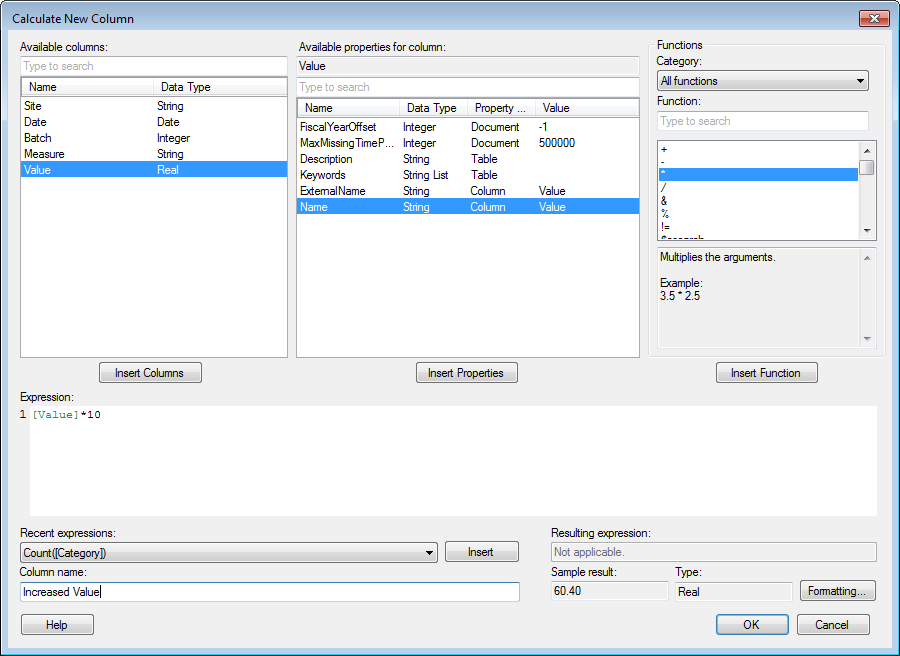
This dialog is used to transform a data table by adding a new calculated column.
To add a Calculate New Column transformation when adding a new data table:
Select File > Add Data Tables... and add the data of interest.
Click Show transformations.
Select Calculate new column from the drop-down list and click Add....
Tip: The Show transformations-section is also available when replacing data tables and when adding columns or rows to a data table.
To add a Calculate New Column transformation to data that is already loaded into Spotfire:
Select Insert > Transformations....
In the Data table drop-down list, select the data table you want to add the transformation to.
Select Calculate new column from the drop-down list and click Add....

Option |
Description |
Available
columns |
Shows all
available columns. Select a column by clicking on it in the list
and then click on the Insert Columns button, or double-click on
the column, to send it to the Expression field. You can narrow
down the list of available columns by typing a part of a name
in the "Type to search" field. You can also enter an
expression in the field, using the rules described on the |
Insert Columns |
Inserts the selected columns in the Expression field. |
Available
properties for column |
Shows all properties that you can use in the calculation of a new column. The column properties are specific to the column selected in the Available columns list to the left. Select a property by clicking on it in the list and then click on the Insert Properties button, or double-click on the property to send it to the Expression field. The property will automatically be inserted as a value in this context. See Properties in Expressions for more information. You can narrow down the list of available properties by using the search field. |
Insert
Properties |
Inserts the properties selected in the Available properties for column list at the current cursor position in the Expression field. |
Category |
Select a category of functions to limit the choices in the Function list: All functions |
Function |
Select a function by clicking on it in the list and then click on the Insert Function button, or double-click on the function to send it to the Expression field. You can narrow down the list by typing a part of a name in the field where it says "Type to search". |
Description |
Shows a brief description of the selected function. For more detailed descriptions, see the Functions chapter. |
Insert Function |
Inserts the selected function in the Expression field. |
Expression |
This is the text field in which you build your expression. You can insert columns and functions from the lists or enter text as in any standard text editor. See Expression and Script Editor Keyboard Shortcuts for information about available shortcuts. |
Recent expressions |
Displays the ten expressions you have most recently created. You can select one of these and click the Insert button to insert the expression into the Expression field. |
Insert |
Inserts the selected Recent expression into the Expression field. This will replace the entire content of the Expression field. |
Resulting
expression |
Of interest when preprocessor functions (such as ${PropertyName}) are used in the expression only. Displays the expression after all occurrences of the property have been replaced with its current value or values. |
Column
name |
Type a name for the calculated column you want to add. |
Sample
result |
Displays the result of applying the current expression to the first row of the data table. Note that if aggregating functions (such as, "Count") are used in the expression, only the first 100 rows will be used in the sample calculation. If this field shows an error there is a problem with the expression. Moving the mouse pointer over the red exclamation mark next to the Expression field will display an explanation of what is wrong. |
Type |
Shows the data type of the new calculated column. |
Formatting... |
Opens the Formatting dialog where you can change the formatting of the new, calculated column. |
See also: